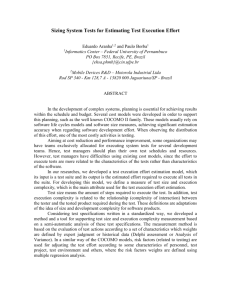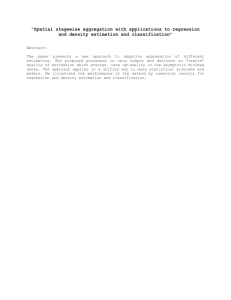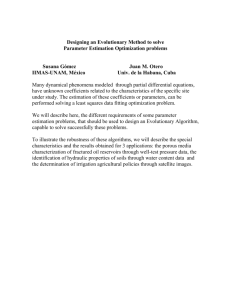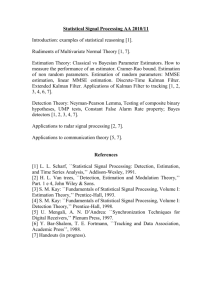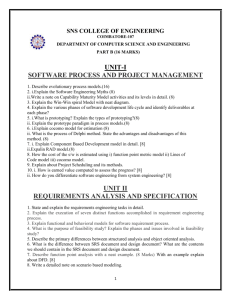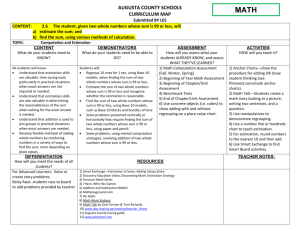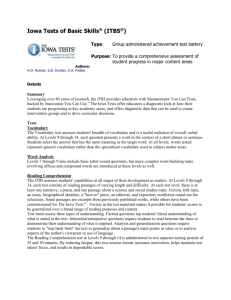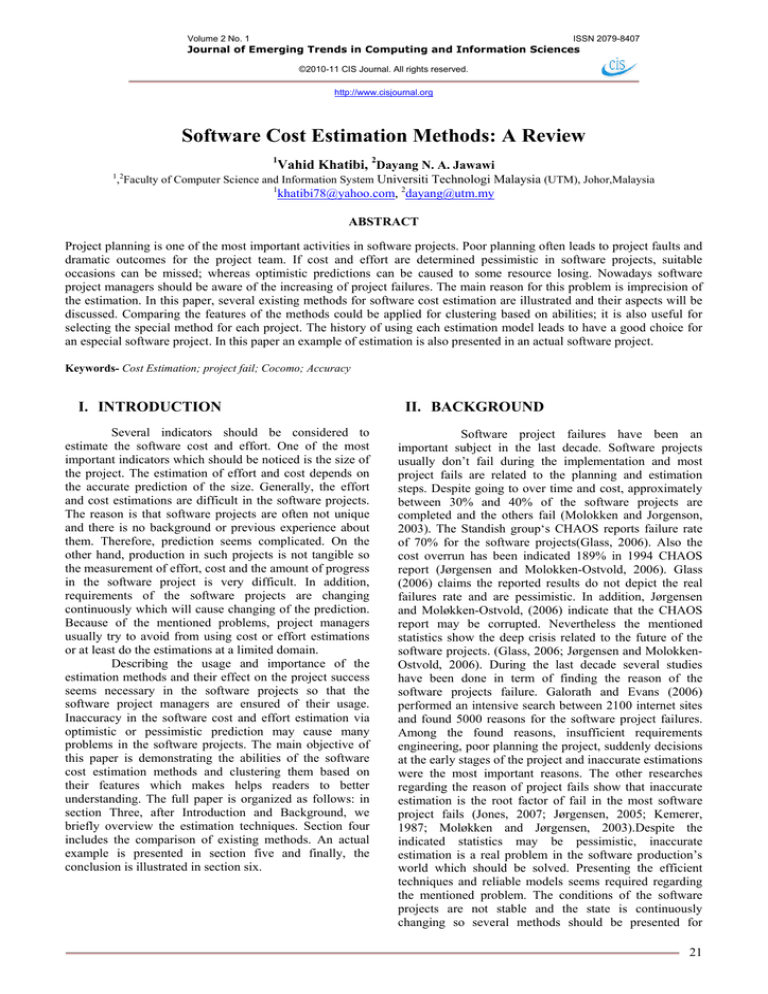
Volume 2 No. 1
ISSN 2079-8407
Journal of Emerging Trends in Computing and Information Sciences
©2010-11 CIS Journal. All rights reserved.
http://www.cisjournal.org
Software Cost Estimation Methods: A Review
1
Vahid Khatibi, 2Dayang N. A. Jawawi
12
, Faculty of Computer Science and Information System Universiti Technologi Malaysia (UTM), Johor,Malaysia
1
khatibi78@yahoo.com, 2dayang@utm.my
ABSTRACT
Project planning is one of the most important activities in software projects. Poor planning often leads to project faults and
dramatic outcomes for the project team. If cost and effort are determined pessimistic in software projects, suitable
occasions can be missed; whereas optimistic predictions can be caused to some resource losing. Nowadays software
project managers should be aware of the increasing of project failures. The main reason for this problem is imprecision of
the estimation. In this paper, several existing methods for software cost estimation are illustrated and their aspects will be
discussed. Comparing the features of the methods could be applied for clustering based on abilities; it is also useful for
selecting the special method for each project. The history of using each estimation model leads to have a good choice for
an especial software project. In this paper an example of estimation is also presented in an actual software project.
Keywords- Cost Estimation; project fail; Cocomo; Accuracy
I. INTRODUCTION
Several indicators should be considered to
estimate the software cost and effort. One of the most
important indicators which should be noticed is the size of
the project. The estimation of effort and cost depends on
the accurate prediction of the size. Generally, the effort
and cost estimations are difficult in the software projects.
The reason is that software projects are often not unique
and there is no background or previous experience about
them. Therefore, prediction seems complicated. On the
other hand, production in such projects is not tangible so
the measurement of effort, cost and the amount of progress
in the software project is very difficult. In addition,
requirements of the software projects are changing
continuously which will cause changing of the prediction.
Because of the mentioned problems, project managers
usually try to avoid from using cost or effort estimations
or at least do the estimations at a limited domain.
Describing the usage and importance of the
estimation methods and their effect on the project success
seems necessary in the software projects so that the
software project managers are ensured of their usage.
Inaccuracy in the software cost and effort estimation via
optimistic or pessimistic prediction may cause many
problems in the software projects. The main objective of
this paper is demonstrating the abilities of the software
cost estimation methods and clustering them based on
their features which makes helps readers to better
understanding. The full paper is organized as follows: in
section Three, after Introduction and Background, we
briefly overview the estimation techniques. Section four
includes the comparison of existing methods. An actual
example is presented in section five and finally, the
conclusion is illustrated in section six.
II. BACKGROUND
Software project failures have been an
important subject in the last decade. Software projects
usually don’t fail during the implementation and most
project fails are related to the planning and estimation
steps. Despite going to over time and cost, approximately
between 30% and 40% of the software projects are
completed and the others fail (Molokken and Jorgenson,
2003). The Standish group‘s CHAOS reports failure rate
of 70% for the software projects(Glass, 2006). Also the
cost overrun has been indicated 189% in 1994 CHAOS
report (Jørgensen and Molokken-Ostvold, 2006). Glass
(2006) claims the reported results do not depict the real
failures rate and are pessimistic. In addition, Jørgensen
and Moløkken-Ostvold, (2006) indicate that the CHAOS
report may be corrupted. Nevertheless the mentioned
statistics show the deep crisis related to the future of the
software projects. (Glass, 2006; Jørgensen and MolokkenOstvold, 2006). During the last decade several studies
have been done in term of finding the reason of the
software projects failure. Galorath and Evans (2006)
performed an intensive search between 2100 internet sites
and found 5000 reasons for the software project failures.
Among the found reasons, insufficient requirements
engineering, poor planning the project, suddenly decisions
at the early stages of the project and inaccurate estimations
were the most important reasons. The other researches
regarding the reason of project fails show that inaccurate
estimation is the root factor of fail in the most software
project fails (Jones, 2007; Jørgensen, 2005; Kemerer,
1987; Moløkken and Jørgensen, 2003).Despite the
indicated statistics may be pessimistic, inaccurate
estimation is a real problem in the software production’s
world which should be solved. Presenting the efficient
techniques and reliable models seems required regarding
the mentioned problem. The conditions of the software
projects are not stable and the state is continuously
changing so several methods should be presented for
21
Volume 2 No. 1
ISSN 2079-8407
Journal of Emerging Trends in Computing and Information Sciences
©2010-11 CIS Journal. All rights reserved.
http://www.cisjournal.org
estimation that each method is appropriate for a special
project.
III. ESTIMATION TECHNIQUES
Generally, there are many methods for software
cost estimation, which are divided into two groups:
Algorithmic and Non-algorithmic. Using of the both
groups is required for performing the accurate estimation.
If the requirements are known better, their performance
will be better. In this section, some popular estimation
methods are discussed.
A. Algorithmic Models
These models work based on the especial
algorithm. They usually need data at first and make results
by using the mathematical relations. Nowadays, many
software estimation methods use these models.
Algorithmic Models are classified into some different
models. Each algorithmic model uses an equation to do the
estimation:
Effort = f(x1, x2, …, xn)
where, (x1…xn) is the vector of the cost factors. The
Differences among the existing algorithmic methods are
related to choosing the cost factors and function. All cost
factors using in these models are:
Product factors: required reliability; product
complexity; database size used; required
reusability; documentation match to life-cycle
needs;
Computer factors: execution time constraint;
main storage constraint; computer turnaround
constraints; platform volatility;
Personnel factors: analyst capability; application
experience; programming capability; platform
experience; language and tool experience;
personnel continuity;
Project factors: multisite development; use of
software tool; required development schedule.
Quantizing the mentioned factors is very
difficult to do and some of them are ignored in some
software projects. In this study several algorithmic
methods are considered as the most popular methods. The
mentioned methods have been selected based on their
reputation. There are many papers which use the selected
algorithmic methods (Musilek, Pedrycz et al. 2002;
Yahya, Ahmad et al. 2008; Lavazza and Garavaglia 2009;
Yinhuan, Beizhan et al. 2009; Sikka, Kaur et al. 2010)
1)
Source Line of Code
SLOC is an estimation parameter that illustrates
the number of all commands and data definition but it does
not include instructions such as comments, blanks, and
continuation lines. This parameter is usually used as an
analogy based on an approach for the estimation. After
computing the SLOC for software, its amount is compared
with other projects which their SLOC has been computed
before, and the size of project is estimated. SLOC
measures the size of project easily. After completing the
project, all estimations are compared with the actual ones.
Thousand Lines of Code (KSLOC) are used for
estimation in large scale. Using this metric is common in
many estimation methods. SLOC Measuring seems very
difficult at the early stages of the project because of the
lack of information about requirements.
Since SLOC is computed based on language
instructions, comparing the size of software which use
different languages is too hard. Anyway, SLOC is the base
of the estimation models in many complicated software
estimation methods. SLOC usually is computed by
considering SL as the lowest, SH as the highest and SM as
the most probable size (Roger S. Pressman, 2005).
S=
SL+ 4SM + SH
6
2)
Function Point Size Estimates
At first, Albrecht (1983) presented Function
Point metric to measure the functionality of project. In this
method, estimation is done by determination of below
indicators:
User Inputs,
User Outputs,
Logic files,
Inquiries,
Interfaces
A Complexity Degree which is between 1 and 3
is defined for each indicator. 1, 2 and 3 stand for simple,
medium and complex degree respectively. Also, it is
necessary to define a weight for each indicator which can
be between 3 and 15.
At first, the number of each mentioned indicator
should be tallied and then complexity degree and weight
are multiplied by each other. Generally, the unadjusted
function point count is defined as below:
where Nij is the number of indicator i with
complexity j and; Wij is the weight of indicator i with
complexity j.
According to the previous experiences,
function point could be useful for software estimations
because it could be computed based on requirement
specification in the early stages of project. To compute the
FP, UFC should be multiplied by a Technical Complexity
Factor (TCF) which is obtained from the components in
Table I.
22
Volume 2 No. 1
ISSN 2079-8407
Journal of Emerging Trends in Computing and Information Sciences
©2010-11 CIS Journal. All rights reserved.
http://www.cisjournal.org
TABLE I Technical Complexity Factor
components
4)
Commonly linear models have the simple
structure and trace a clear equation as below:
F1
Reliable back-up
and recovery
F8
Data
communications
F2
Distributed
functions
F9
Performance
F3
Heavily used
configuration
F10
Online data entry
F4
Operational ease
F11
Online update
F5
Complex interface
F12
Complex
processing
F6
Reusability
F13
Installation ease
F7
Multiple sites
F14
Facilitate change
(8)
where,a1,a2..,an are selected according to the project
information.
5)
Each component can change from 0 to 5. 0 and 5 indicate
that the component has no effect on the project and the
component is compulsory and very important respectively.
Finally, the TCF is calculated as:
TCF = 0.65+0.01(SUM (Fi))
The range of TCF is between 0.65 (if all Fi are 0) and 1.35
(if all Fi are 5). Ultimately, Function Point is computed as:
3)
Multiplicative models
The form of this model is as below:
where, a1, …, an are selected according to the project
information . In this formula, only allowed values for xi
are -1,0 and +1.
6)
FP=UFC*TCF
Linear Models
Seer-Sem
SEER-SEM model has been proposed in 1980 by
Galorath Inc (Galorath, 2006). Most parameters in this
method are commercial and, business projects usually use
SEER-SEM as their main estimation method. Size of the
software is the most important feature in this method and a
parameter namely Se is defined as effective size. Se is
computed by determining the five indicators : newsize,
existingsize, reimpl and retst as below:
COCOMO
Cost models generally use some cost indicators
for estimation and notice to all specifications of artifacts
and activities. COCOMO 81 (Constructive Cost Model),
proposed by Barry Boehm (Boehm, 1981), is the most
popular method which is categorized in algorithmic
methods. This method uses some equations and
parameters, which have been derived from previous
experiences about software projects for estimation.
COCOMO-II is the latest version of COCOMO that
predicts the amount of effort based on Person-Month (PM)
in the software projects.
It uses function point or line of code as the size
metrics and composes of 17 Effort Multipliers (shown in
Table II) and 5 scale factors (shown in Table III). Some
rating levels are defined for scale factors including very
low, low, nominal, high, very high and extra high. A
quantitative value is assigned to each rating level as its
weight.
COCOMO II has some special features, which
distinguish it from other ones. The Usage of this method is
very wide and its results usually are accurate.
Two equations are used to estimate effort and schedule as
below:
Se=Newsize+ExistingSize(0.4Redesign+0.25reimp+0.35
Retest)
After computing the Se the estimated effort is calculated as
below:
(7)
where D is relevant to the staffing aspects; it is determined
based on the complexity degree in staffs structure. Cte is
computed according to productivity and efficiency of the
project method is used widely in commercial projects.
(Fischman,L.This ,2005)
(11)
23
Volume 2 No. 1
ISSN 2079-8407
Journal of Emerging Trends in Computing and Information Sciences
©2010-11 CIS Journal. All rights reserved.
http://www.cisjournal.org
TABLE II
Attribu
te
RELY
Product
CPLX
Product
DOCU
Product
DATA
Product
RUSE
Product
Effort Multipliers
Type
Description
Required system reliability
Complexity of system
modules
Extent of documentation
required
Size of database used
Required percentage of
reusable components
TOOL
Comput
er
Comput
er
Comput
er
Personn
el
Personn
el
Personn
el
Personn
el
Personn
el
Personn
el
Project
SCED
Project
SITE
Project
TIME
PVOL
STOR
ACAP
PCON
PCAP
PEXP
AEXP
LTEX
Execution time constraint
Volatility of development
platform
Memory constraints
Capability of project analysts
This model has been proposed by Putman
according to manpower distribution and the examination
of many software projects (Kemerer,2008). The main
equation for Putnam’s model is:
where, E is the environment indicator and demonstrates
the environment ability. Td is the time of delivery. Effort
and S are expressed by person-year and line of code
respectively. Putnam presented another formula for Effort
as follows:
where, D0 , the manpower build-up factor, varies from
8(new software) to 27(rebuilt software). By combining
equations 12 and 13, the final equation is obtained as:
(14)
Personnel continuity
Programmer capability
Programmer experience in
project domain
Analyst experience in project
domain
Language and tool experience
Use of software tools
Development schedule
compression
Extent of multisite working
and quality of inter-site
communications
TABLE III Scale factors
Factor
Precedentedn
ess
(PREC)
Development
Flexibility
(FLEX)
Risk
Resolution
(RESL)
Team
Cohesion
(TEAM)
Process
maturity
(PMAT)
7) Putman’s model
Explanation
Reflects the previous experience
of the
organization
Reflects the degree of flexibility
in the
development process.
Reflects the extent of risk
analysis carried out.
Reflects how well the
development team knows each
other and work together.
Reflects the process maturity of
the organization.
(15)
SLIM (Software Life Cycle Management) is a tool that
acts according to the Putnam’s model.
B. Non Algorithmic Methods
Contrary to the Algorithmic methods, methods of
this group are based on analytical comparisons and
inferences. For using the Non Algorithmic methods some
information about the previous projects which are similar
the under estimate project is required and usually
estimation process in these methods is done according to
the analysis of the previous datasets. Here, three methods
have been selected for the assessing because these
methods are more popular than the other None
Algorithmic methods and many papers about their usage
have been published in the recent years(Idri, Mbarki et al.
2004; Braz and Vergilio 2006; Li, Xie et al. 2007; Keung,
Kitchenham et al. 2008; Li, Lin et al. 2008; Jianfeng,
Shixian et al. 2009; Jorgensen, Boehm et al. 2009;
Pahariya, Ravi et al. 2009; Cuadrado-Gallego, Rodri et al.
2010).
1)
Analogy
In this method, several similar completed
software projects are noticed and estimation of effort and
cost are done according to their actual cost and effort.
Estimation based on analogy is accomplished at the total
system levels and subsystem levels. By assessing the
results of previous actual projects, we can estimate the
cost and effort of a similar project. The steps of this
method are considered as:
i.
ii.
iii.
iv.
Choosing of analogy
Investigating similarities and differences
Examining of analogy quality
Providing the estimation
24
Volume 2 No. 1
ISSN 2079-8407
Journal of Emerging Trends in Computing and Information Sciences
©2010-11 CIS Journal. All rights reserved.
http://www.cisjournal.org
In this method a similarity function is defined
which compares features of two projects. There are two
popular similarity function namely Euclidean similarity
(ES) and Manhattan similarity (MS) (Shepperd, M,
Schofield, C,1997, Chiu , N, Huang, S.J,2007).
Figure1. An example of using Delphi
3)
p and p' are projects wi is the weight is assigned
to each feature and varies between 0 and 1. Fi and fi'
display the ith feature of each project and n demonstrates
the number of features. δ is used for obtaining the none
zero results. The MS formula is very similar to ES but it
computes the absolute difference between features.
Machine learning Models
Most techniques about software cost estimation
use statistical methods, which are not able to present
reason and strong results. Machine learning approaches
could be appropriate at this filed because they can increase
the accuracy of estimation by training rules of estimation
and repeating the run cycles. Machine learning methods
could be categorized into two main methods, which are
explained in the next subsections.
a) Neural networks
2)
Expert judgment
Estimation based on Expert judgment is done by
getting advices from experts who have extensive
experiences in similar projects. This method is usually
used when there is limitation in finding data and gathering
requirements. Consultation is the basic issue in this
method. One of the most common methods which works
according to this technique, is Delphi. Delphi arranges an
especial meeting among the project experts and tries to
achieve the true information about the project from their
debates. Delphi includes some steps:
i. The coordinator gives an estimation form to each
expert.
ii. Each expert presents his own estimation (without
discussing with others)
iii. The coordinator gathers all forms and sums up them
(including mean or median) on a form and ask
experts to start another iteration.
iv. steps (ii-iii) are repeated until an approval is
gained.
Neural networks include several layers which
each layer is composed of several elements called neuron.
Neurons, by investigating the weights defined for inputs,
produce the outputs. Outputs will be the actual effort,
which is the main goal of estimation.
Back propagation neural network is the best
selection for software estimation problem because it
adjusts the weights by comparing the network outputs and
actual results. In addition, training is done effectively.
Majority of researches on using the neural networks for
software cost estimation, are focused on modeling the
Cocomo method, for example in (Attarzadeh, Ow, 2010) a
neural network has been proposed for estimation of
software cost according to the following figure. Figure 2
shows the layers, inputs and the transfer function of the
mentioned neural network. Scale Factors(SF) and effort
multipliers(EM) are input of the neural network, pi and qj
are respectively the weight of SFs and EMs.
Figure 1 shows an example of using Delphi
technique in which eight experts contributed and final
convergence was determined after passing four stages
(Mahmud S et al. ,2008).
Figure2. An example of using Neural Network
25
Volume 2 No. 1
ISSN 2079-8407
Journal of Emerging Trends in Computing and Information Sciences
©2010-11 CIS Journal. All rights reserved.
http://www.cisjournal.org
b) Fuzzy Method
All systems, which work based on the fuzzy logic
try to simulate human behavior and reasoning. In many
problems, which decision making is very difficult and
conditions are vague, fuzzy systems are an efficient tool in
such situations. This technique always supports the facts
that may be ignored. There are four stages in the fuzzy
approach:
Stage 1: Fuzzification: to produce trapezoidal numbers
for the linguistic terms.
Stage 2: to develop the complexity matrix by producing
a new linguistic term.
Stage 3: to determine the productivity rate and the
attempt for the new linguistic terms.
Stage 4: Defuzzification: to determine the effort
required to complete a task and to compare the existing
method.
For example in (Attarzadeh, Ow, 2010) Cocomo technique
has been implemented by using fuzzy method. The Figure
3 displays all mentioned steps; In the first step
fuzzification has been done by scale factors, cost drivers
and size . In step 2, principals of Cocomo are considered
and defuzzification is accomplished to gain the effort.
done based on capabilities of methods and state of the
project. Table IV shows a comparison of mentioned
methods for estimation. For doing comparison, the popular
existing estimation methods have been selected.
TABLE IV Comparison of the existing
methods
Method
COCOM
O
Expert
Judgmen
t
Function
Point
Analogy
Neural
Network
s
Fuzzy
Type
Algorithm
ic
NonAlgorithm
ic
Algorithm
ic
NonAlgorithm
ic
NonAlgorithm
ic
NonAlgorithm
ic
Advantages
Clear results,
very common
Fast
prediction,
Adapt to
especial
projects
Language free,
Its results are
better than
SLOC
Works based
on actual
experiences,
having
especial expert
is not
important
Consistent
with unlike
databases,
Power of
reasoning
Training is not
required,
Flexibility
Disadvantages
Much data is
required, It ‘s not
suitable for any
project,
Its success depend
on expert, Usually
is done incomplete
Mechanization is
hard to do ,
quality of output
are not considered
A lots of
information about
past projects is
required, In some
situations there are
no similar project
There is no
guideline for
designing, The
performance
depends on large
training data
Hard to use,
Maintaining the
degree of
meaningfulness is
difficult
Figure 3. An example of using Fuzzy method
IV. COMPARISON
OF
ESTIMATION METHODS
THE
At this section according to the previous
presented subjects, it is possible to compare mentioned
estimation methods based on advantages and
disadvantages of them.This comparison could be useful
for choosing an appropriate method in a particular project.
On the other hand, selecting the estimation technique is
According to the current comparison and based
on the principals of the algorithmic and non algorithmic
methods(described in previous sections); for using the non
algorithmic methods it is necessary to have the enough
information about the same previous projects because
these methods perform the estimation by analysis of the
historical data. Also, non algorithmic methods are easy to
learn because all of them follow the human behavior. On
the other hand, Algorithmic methods are based on
mathematics and some experimental equations. They are
26
Volume 2 No. 1
ISSN 2079-8407
Journal of Emerging Trends in Computing and Information Sciences
©2010-11 CIS Journal. All rights reserved.
http://www.cisjournal.org
usually hard to learn and they need to the much data about
the current project state. But if enough data is reachable,
these methods present the reliable results. In addition,
algorithmic methods usually are complementary to each
other , for example, Cocomo uses the SLOC and Function
Point as two input metrics and generally if these two
metrics are accurate , the Cocomo presents the accurate
results too. Finally , for selecting the best method to
estimate, looking at available information of the current
project and the same previous projects data could be
useful.
V. HOW TO EVALUATE THE RESULTS
OF AN ESTIMATION METHOD
After knowing estimation methods and
comparing them with each other, illustrating their abilities
via some actual projects seems to be useful. The
acceptance of using these methods has been a challenge
since many years ago. In this section, we try to show the
minimum distance between estimated parameters and
actual ones in an experience. Measuring the performance
of estimation methods is accomplished by computing
several metrics including RE (Relative Error), MRE
(Magnitude of Relative Error) and MMRE (Mean
Magnitude of Relative Error). They are the popular
parameters which are used for performance evaluation of
methods.
RE=(Estimated PM – Actual PM)/(Actual PM)
MRE=|Estimated PM – Actual PM|/(ActualPM)
Another parameter used for performance evaluation is
PRED (Percentage of the Prediction) which is calculated
as:
MMRE=∑MRE
PRED(X)=A/N
where, A is the number of projects with MRE less than or
equal to X and N is the number of considered projects.
A. An actual estimation by Cocomo
Since CCOCOMO II is the most popular method
used for estimation, in this section, a real project effort
estimation is demonstrated based on COCOMO II metrics.
Table V shows the cost drivers and their adjusted amounts
which are related to a real project. In (Maged A. Yahya et
al. ,2008) all data about thirty software projects has been
gathered from organizations by distributing the
questionnaire. The scope of activities in mentioned
organizations is banking, insurance,web development,
communication and so on . For illustrating executive
capabilities of Cocomo, we used only one project data of
thirty projects which has been recorded in the dataset.
TABLE II Effort Multipliers
Cost Driver
Degree
Value
RELY
Very High
1.1
DATA
Very high
1.28
RUSE
Very High
1.15
DOCU
Nominal
1
TIME
High
1.11
STOR
High
1.05
PVOL
Low
0.87
ACAP
Very high
0.71
PCAP
Very High
0.76
PCON
Very high
0.81
APEX
Very high
0.81
PLEX
Very High
0.85
LTEX
Very High
0.84
TOOL
Very High
0.78
SITE
Very High
0.86
SCED
Nominal
1
CPLX
High
1.17
Before using Cocomo II formulas, it is necessary
to adjust scale factors. Table VI shows the scale factors
which are arranged for this project.
TABLE VI. Scale Factors
Scale Factor
Level
Value
PREC
FLEX
RESEL
TEAM
PMAT
High
Nominal
High
Very High
Very High
2.48
3.04
2.83
1.10
1.56
Real effort for this project is 117.92 personmonth, real time is 15.5 months and size of the project
(KSLOC) is 130. Now by using cost drivers, scale factors
and relations 10, 11 and 19 parameters are estimated as:
PM= 2.94 * (130) 0.91+0.01*11.01 * 0.326=137.4
TDEV= 3.67*(137.4)0.28+0.2*0.01*11.01 =16.23
MRE= (137.4-117.92)/117.92 =0.17
As it is seen, the difference of actual parameters
and estimated ones is very low somehow the MRE is 0.17
which is the reasonable value. It was only a sample to
27
Volume 2 No. 1
ISSN 2079-8407
Journal of Emerging Trends in Computing and Information Sciences
©2010-11 CIS Journal. All rights reserved.
http://www.cisjournal.org
show the applicable ability of COCOMO method. By
calibration, the accuracy of metric results in this method
will be increased.
[5]
Boehm, B. W., & Valerdi, R. “Achievements and
challenges in cocomo-based software resource
estimation”,
IEEE
Software,
25(5),7483.doi:10.1109/MS ,2008.
[6]
Boehm,“Software
Prentice Hall,1981.
[7]
Chiu , N.H., Huang, S.J., “The adjusted analogybased software effort estimation based on
similarity distances”, Journal of Systems and
Software 80 (4), 628–640.2007.
[8]
Cuadrado-Gallego, J. J., Rodri, et al. “Analogies
and Differences between Machine Learning and
Expert Based Software Project Effort Estimation”.
Software Engineering Artificial Intelligence
Networking and Parallel/Distributed Computing
(SNPD), 11th ACIS International Conference
on,2010.
[9]
Fischman,L, K. McRitchie, and D.D. Galorath,”
Inside SEER-SEM”, CrossTalk, The Journal of
Defense Software Engineering, 2005.
VI. CONCLUSION
Finding the most important reason for the
software project failures has been the subject of many
researches in last decade. According to the results of
several researches presented in this paper, the root cause
for software project failures is inaccurate estimation in
early stages of the project. So introducing and focusing on
the estimation methods seems necessary for achieving to
the accurate and reliable estimations. In current study most
of the present estimation techniques have been illustrated
systematically. Since software project managers are used
to select the best estimation method based on the
conditions and status of the project, describing and
comprising of estimation techniques can be useful for
decreasing of the project failures. There is no estimation
method which can be present the best estimates in all
various situations and each technique can be suitable in
the special project. It is necessary understanding the
principals of each estimation method to choose the best.
Because performance of each estimation method depends
on several parameters such as complexity of the project ,
duration of the project, expertise of the staff, development
method and so on. Some evaluation metrics and an actual
estimation example have been presented in this paper just
for describing the performance of an estimation
method(for example Cocomo). Trying to improve the
performance of the existing methods and introducing the
new methods for estimation based on today’s software
project requirements can be the future works in this area.
REFERENCES
[1]
[2]
[3]
[4]
Attarzadeh,I. Siew Hock Ow, “Proposing a New
Software Cost Estimation Model Based on
Artificial Neural Networks”,IEEE International
Conference on Computer Engineering and
Technology (ICCET) , Volume: 3, Page(s): V3487 - V3-491 2010.
Attarzadeh, I. Siew Hock Ow,”Improving the
accuracy of software cost estimation model based
on a new fuzzy logic model”,World Applied
science journal 8(2):117-184,2010-10-2.
Albrecht.A.J. and J. E. Gaffney, “Software
function, source lines of codes, and development
effort prediction: a software science validation”,
IEEE Trans Software Eng. SE,pp.639-648, 1983.
Braz, M. R. and S. R. Vergilio . “Software Effort
Estimation Based on Use Cases”. Computer
Software
and
Applications
Conference,
COMPSAC '06. 30th Annual International,2006.
Engineering
Economics”,
[10] Galorath, D. D., & Evans, M. W. “ Software
sizing, estimation, and risk management: When
performance is measured performance improves”.
Boca Raton, FL: Auerbach,2006.
[11] Idri, A., S. Mbarki, et al. “ Validating and
understanding software cost estimation models
based on neural networks”. Information and
Communication Technologies: From Theory to
Applications,
2004.
Proceedings.
2004
International Conference on,2004.
[12] Jones, C. “Estimating software costs: Bringing
realism to estimating (2nd ed.)”. New York, NY:
McGraw-Hill, 2007.
[13] Jianfeng, W., L. Shixian, et al. “ Improve
Analogy-Based Software Effort Estimation Using
Principal Components Analysis and Correlation
Weighting”. Software Engineering Conference,
2009. APSEC '09. Asia-Pacific,2009.
[14] Jorgensen, M., B. Boehm, et al. "Software
Development Effort Estimation: Formal Models or
Expert Judgment?" Software, IEEE 26(2): 1419,2009.
[15] Jørgensen, M.“Practical guidelines for expert-judg
ment-based software effort estimation”, IEEE
Software, 22(3), 57-63. doi:10.1109/MS. 73, 2005.
[16] Keung, J. W., B. A. Kitchenham, et al. "AnalogyX: Providing Statistical Inference to AnalogyBased Software Cost Estimation." Software
28
Volume 2 No. 1
ISSN 2079-8407
Journal of Emerging Trends in Computing and Information Sciences
©2010-11 CIS Journal. All rights reserved.
http://www.cisjournal.org
Engineering, IEEE Transactions on 34(4): 471484,2008.
[17] Kemerer, C. “An empirical validation of software
cost estimation models”, Communications of the
ACM, 30(5), 416-429. doi: 10.1145/22899. 22906
,1987.
[18] Lavazza, L. and C. Garavaglia “Using function
points to measure and estimate real-time and
embedded software: Experiences and guidelines”.
Empirical Software Engineering and Measurement
ESEM 2009. 3rd International Symposium
on,2009.
[24] Moløkken, K., & Jørgensen, M.” A review of
surveys on software effort estimation. International
Symposium on Empirical Software Engineering”,
223-231. Retrieved from ACM Digital Library
database,2003.
[25] Shepperd, M., Schofield, C,” Estimating software
project effort using analogies”.IEEE Transactions
on Software Engineering 23 (12), 733–743.1997.
[26] Pressman, Roger S. ” Software Engineering: A
Practioner's Approach”, 6th Edn., McGraw-Hill
New
York,
USA.,
ISBN:
13:
9780073019338,2005
[19] Li, J., J. Lin, et al.” Development of the Decision
Support System for Software Project Cost
Estimation. Information Science and Engineering”,
2008. ISISE '08. International Symposium
on,2008.
[27] Pahariya, J.
estimation
techniques".
Computing,
on,2009.
[20] Li, Y. F., M. Xie, et al. “A study of genetic
algorithm for project selection for analogy based
software cost estimation. Industrial Engineering
and
Engineering
Management”,
IEEE
International Conference on,2007
[28] Sikka, G., A. Kaur, et al. " Estimating function
points: Using machine learning and regression
models". Education Technology and Computer
(ICETC), 2nd International Conference on,2010.
[21] Mahmud S. Alkoffash, Mohammed J. Bawaneh
and Adnan I. Al Rabea,”Which Software Cost
Estimation Model to Choose in a Particular
Project”, Journal of Computer Science 4 (7): 606612, 2008.
[22] Maged A. Yahya, Rodina Ahmad, Sai Peck Lee,”
Effects of Software Process Maturity on
COCOMO II’s Effort Estimation from CMMI
Perspective”,978-1-4244-2379-8/08 IEEE (c),
2008 .
S., V. Ravi, et al."Software cost
using computational intelligence
Nature & Biologically Inspired
NaBIC 2009. World Congress
[29] Yahya, M. A., R. Ahmad, et al." Effects of
software process maturity on COCOMO
II’s effort estimation from CMMI
perspective". Research, Innovation and Vision for
the Future, RIVF. IEEE International Conference
on,2008.
[30] Yinhuan, Z., W. Beizhan, et al. "Estimation of
software projects effort based on function point".
Computer Science & Education. ICCSE. 4th
International Conference on,2009.
[23] Musilek, P., W. Pedrycz, et al. “On the sensitivity
of COCOMO II software cost estimation model”.
Software Metrics, Proceedings. Eighth IEEE
Symposium on,2002.
29

